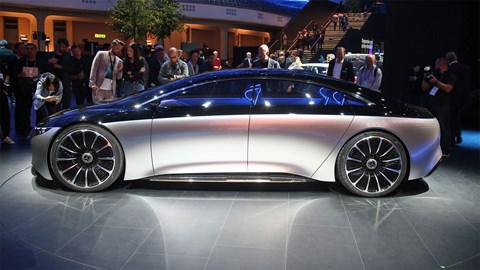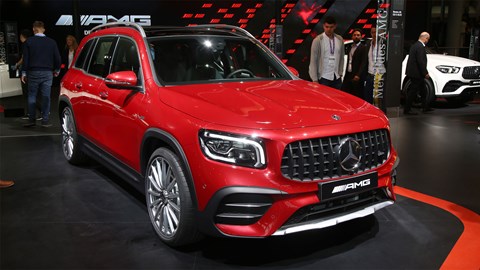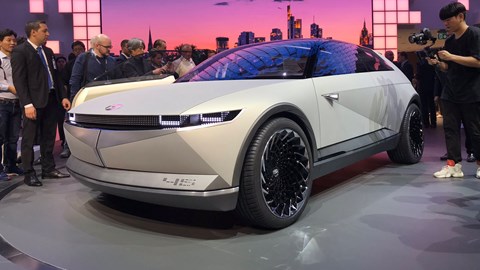► The best and worst cars at Frankfurt
► Full 2019 IAA motor show review
► No punches pulled in our round-up
Ask any hack which motor show in the calendar they most dread and the answer is unanimous: Frankfurt. The sheer scale of the Internationale Automobil Ausstellung (or IAA, for short) is mind-boggling, a citadel of concrete and cars, launches and lightshows. With 400,000 square metres of exhibition space, the Frankfurt Messe usually blares with the might of the global auto industry in its pomp. But in 2019, it was a more muted celebration of all things four-wheeled.
Frankfurt was quieter than usual in 2019. Some halls lay dormant. Numerous brands - Nissan, Fiat, Peugeot, Citroen, Volvo, to name a handful - were absent, marketing chiefs carefully counting their euros as the industry rethinks old habits. One board member confided that a typical mainstream manufacturer would budget around £50 million a year on motor shows if they attended all the majors. 'They clobber you three times: once for the hallspace, once for the build and once for the staffing...'
No wonder brands are reassessing their spend and rumours were rife of attendance costs being slashed. Ford and Renault were both snuck away in weird outposts with minimal footfall, despite launching important small crossovers the Puma and Captur. The established order of things is changing, fast.
If our feet were saved (a little) this year, we were still treated to some extraordinary cars - just fewer of them. The 2019 Frankfurt motor show was a little more restrained, a little more uncertain. Brexit chaos was on many an executive's lips, digital and EV disruption never more than a keystroke away. Razzmatazz was out and circumspection was in, a backdrop as stark as Greenpeace's impromptu climate change demo at the main entrance earlier in the morning.
Our Frankfurt motor show A-Z guide: every new car that matters

Of course, if the protestors had actually visited the IAA halls within the Messe complex, they would have found many stands bursting with the latest low-CO2 technology. Frankfurt 2019 had it all - from electric cars to hydrogen fuel-cells, lightweighted internal combustion engine cars to electric scooters and new, last-mile solutions. It certainly kept us reporters on our toes, as we strode to our next interview, fearful we may be mown down by a silent EV shuttle at any moment.
Electric cars were, predictably, everywhere. After years of hearing BEVs, EVs and PHEVs were in the pipeline, this is the year when those pipes finally splurged. From mainstream electrics like the Volkswagen ID.3 and Vauxhall Corsa-e, to swankier Porsche Taycans and plug-in Mercs, this was proof that manufacturers are taking their CO2 responsibilities very seriously indeed. But only because they're on final warning.
'We will fully launch electric cars in 2020 and our new Corsa-e will make up 10% of all Corsa sales,' said wily industry veteran Stephen Norman, managing director of Vauxhall. 'That's not a demand-led figure, it's a compliance-led number.' Tellingly, he admitted that diesel would play a greater part in lowering group corporate emissions in future - Vauxhall's share of UK diesel sales has slumped to just 3% and that needs to rise.
VW's brave new world
It's ironic that the brand that accelerated the move towards electrification by cheating in emissions tests four years ago was back and seemingly in rude health. The reverberations from dieselgate are still being felt across the industry, and nowhere more than in Germany - it was fitting that Volkswagen chose the 2019 IAA to rebrand itself with a perplexing overhaul of the timeless logo: a new badge for a new era.
Our guide to electric Volkswagens

There's no mistaking how important the ID.3 and its ilk are. CEO Herbert Diess proclaimed his new baby as significant as the launch of the original Beetle or Golf, heralding a new age of electromobility - and opportunity. EVs are a way of pivoting Volkswagen away from its dirty, diesely, devious past towards a brighter future. Especially if Diess can deliver on his plan to spin 70 variants off its new-fangled MEB e-platform by 2028, which will rapidly cascade across the group (and beyond; they'll sell you a white label skateboard if your pockets are deep enough). There's gold in those lithium cells...
British importers were reporting positively on Tesla's sales figures last month, after its Model 3 stormed to third in the best-sellers chart. A remarkable achievement. Yet for every battery pack and charging cable posing a trip hazard at Frankfurt, it was notable how the internal combustion engine was fighting back: from the sensible but chic Hyundai i10 to the facelifted Vauxhall Astra whose CO2 tumbles by a fifth, there was evidence that petrol and diesel won't go away without a fight.
That's the complexity faced by manufacturers in 2019: engineering directors are caught in a perfect storm - forced to add ever pricier exhaust treatment to internal combustion engines (ICE), which will predominate throughout the next decade, yet also pay burgeoning R&D costs to fund the electric revolution. No wonder European city cars are being squeezed out of production; Ford is dumping the Ka+ and Vauxhall is axing the Viva and Adam too.
Defender of the faith
And so to many visitors' star of the show (and star of the new October 2019 issue of CAR magazine out now). The new Land Rover Defender has been a long time coming - eight years, in fact. For that is when Gaydon showed off its DC100 twins, here in Frankfurt in 2011. The ensuing debate over the icon's future direction, and vacuum left by the deceased original in 2016, has stoked opinion to levels of divisiveness not seen since Brexit. Sorry, that B word again.

The Landie drew the biggest crowds of the day for the world premiere at 10am. They witnessed a remarkable array of Defenders, from 90s and 110s, to jungle-spec off-roaders and commercials on steel wheels. We just hope they can back up the cool aesthetic and laser-guided customer insight with the quality manufacturing, reliability and engineering integrity that is expected at this £40k price point. It was a big moment for CEO Ralph Speth, who was reportedly honoured with a knighthood on the same day he whisked the covers off the Defender.
The 2020 Defender won't please everyone; we know this since bumping into colleague Neil Watterson, who edits Land Rover Owner International magazine, and is closer to the LR community than anyone else I know. 'On balance I like it, but our readers' views are flip-flopping between happy and hate,' he reports. 'The one thing we're hearing a lot is that it's too expensive. I think it's going to eat into Discovery sales substantially...'
Jaguar had a quiet show, kowtowing to its sister brand's big day - but BMW next door had a rather busier press conference - and its main launch got tongues wagging for all the wrong reasons. Munich might have pioneered electrification among premium brands this past decade and many of its mainstream cars (3-series, 5-er) are as strong as they've ever been, but the Concept 4 concept rang further alarm bells with that over-wrought grille. Will we look back in 10 years' time and judge this another Banglesque era of reinvention, a painful but necessary design jolt? We fear not.

Better news over at Mercedes-Benz, whose EQS showed how progressive design can be applied to executive sectors. Munich might have stolen a march on electrification nearly a decade ago with its megacity vehicle that begat i3, but Stuttgart appears to have caught up, judging by the flurry of EVs from Merc and Porsche. The Taycan, making its motor show debut, looks especially on-point - a confident promise that the old world and the new can coexist just fine.
Hall 3 was home to the Volkswagen Group and you couldn't move for electrified models: even high-octane Lamborghini was at it, with the marvellously OTT Sian, its first hybrid production car that relies on supercapacitors. This blunderbuss group approach, ranging from standalone Cupra Tavascan crossover to Audi AI Trail adventure wagon, suggests either an abundance of fresh thinking in Wolfsburg or a desperate ploy to make their battery-powered cars stand out from the crowd.
It's ironic when most brands, not least those in the VW empire, are busy reining in their ambitions, Audi CEO Bram Schot confirming the elimination of as many as a quarter of its derivatives to strip costs and range complexity. This correction feels overdue.
It's a time for prudence: to beat the Brexit uncertainties that may yet cause a crash in the UK car market, according to many senior figures in the industry; to pay the huge bills for electrification and digitisation; and to understand the role of the car in a rapidly changing world. And yet that potent cocktail of events also calls for brave decisions. It's not a time to sleepwalk on, producing mediocre, so-so cars.
On the evidence of the 2019 Frankfurt motor show, the industry will survive this bumpy new decade that stretches before us. But some manufacturers will thrive more than others.
Do you agree with Tim Pollard's verdict? Be sure to sound off in the comments below
Join us here as three of CAR's key Frankfurt reporters list their hits and misses from this year's show.
Frankfurt threes: Ben Miller, editor of CAR magazine
HIT: Land Rover Defender (below)
Land Rover finds itself in the very fortunate position of having to replace an icon almost every time it does a new car. But they don’t come any bigger than this, the new Defender; nothing less than the car that created the company, and one with a vast, tribal audience not short on strong views. New Defender delivers absolutely. It looks right: a simple-sounding word of praise but the biggest compliment you can pay. And the depth of engineering is entirely convincing, from the rugged aluminium monocoque through an all-new electronics architecture to white steel wheels. The long wait is over; the wanting begins.

HIT: Porsche Taycan
The ferocious standing start you expect: Teslas do that. It’s the complete lack of mid-corner roll, the agility and our test driver’s confidence to hold the Turbo S Taycan we rode in sideways, on a wet stretch of track, at speed, with no meaningful run-off, that helps you realise that this isn’t merely an electric Porsche: it’s a deadly serious Porsche that just happens to be electric. I love the exterior design. I love the fact that Porsche engineered a bespoke two-speed gearbox to reduce current flow and allow the Taycan to use slimmer, lighter cables. I love the optional wheels from the Mission E. And I love that, in the electric future, everything’s going to be okay.
HIT: Mercedes EQS Concept (below)
Gorden Wagener’s design team must have been laughing their socks off. A few months ago, CAR magazine put together a dossier of all we knew about Merc’s big EQ, the S. We weren’t far wide of the mark on much of it. Fortunately, we were massively wide of the mark on the way it would look, assuming the single-volume, slug-like form of some of Merc’s previous battery-electric concepts would be used for this new near-silent flagship. We were wrong. The EQS ‘concept’ looks magnificent. As if a Mercedes S-Class would be anything less.

MISS: BMW Concept 4
I don’t get it. Yes, be proud of your kidney grilles. But don’t just make them bigger and bigger until they’re all you can see. Fundamentally the Concept 4’s not bad, but the inelegant grilles are symptomatic of a lack of rigour and sophistication at BMW design that worries me. That no one seems sure how the i, M and mainstream BMW brands fit together is also worrying. So, i is always high-performance and electrified, but M – implicitly high-performance – will also be electrified? And mainstream BMW design is borrowing i’s ultra-clean surfacing? Sorry, you’ve lost me…
MISS: AMG GLB35 (below)
It’s not big and it’s not clever, and perhaps Mercedes should be using its might to save the planet or revolutionise mobility. But none of that changes the fact that the GLB was already a ferociously well-judged bit of kit – the addition now of a 35 AMG just ups the desirability to frankly dangerous levels, thanks to a 302bhp 2.0-litre turbo four and the kind of stance over low-profile multi-spokes usually reserved for the DTM paddock. There are far more progressive cars out there and I found myself liking this car despite knowing that I shouldn’t.

MISS: Bugatti Chiron Super Sport 300+
Okay, so it’s not actually at Frankfurt. But the Super Sport 300+ was announced on the same timeframe, and it’s a fascinating, remarkable feat. For a long while the Veyron, in its tortuous R&D gestation, struggled to make 800bhp. Now it’s kicking out twice that. But this weapons-grade Chiron isn’t the most interesting thing going on at Bugatti; that’s the second model that’ll ensure ongoing stability and profitability. A Type 35-influenced sportster? It might lack the business case of a CUV badged Royale but all options are being considered.
Frankfurt threes: Jake Groves, staff writer
HIT: Porsche Taycan (below)
Genuinely excited to drive it, think it looks the dog’s what-nots and it stays remarkably true to the original Mission E concept. This is surely the electric sportster to hit Tesla where it hurts.

HIT: Hyundai 45 Concept
An absolute killer design from Korea and I love the retro vibe of this Hyundai 45 Concept. If usually sensible Hyundai can make anything like this properly, sign me up.
HIT: Lamborghini Sian
The Lamborghini Sian is even more dramatic in the metal and composite than the pictures suggest, though I don’t like the fussy, typically OTT rear end. Clever use of e-innovation and will be one of the few genuinely terrifying supercars you can buy. These hardly exist anymore…

MISS: Hyundai i30 N Project C
A miss because it's not coming to the UK. While I rate the regular i30 N hot hatch, I think a lighter, more hardcore version would be an absolute riot.
MISS: BMW Concept 4
A generally gorgeous piece of design ruined by one of the worst versions of the kidney grille yet. Hopefully the production 4-series won’t be quite as cack when it arrives in 2021.

MISS: Audi A1 CityCarver
The poshest Rover Streetwise clone yet? This derivative-too-far A1 doesn’t even look that different from the regular hatchback.
Frankfurt threes: Keith Adams, editor of our sister site Parkers.co.uk
HIT: Volkswagen ID.3
Volkswagen is working hard to redeem and reinvent itself after Dieselgate, and in doing so much to democratise the EV, it might just manage it. First impressions of the ID.3are that it looks terrific, isn't as roomy as I was hoping it to be, but if it goes anywhere near as far on a full charge as they claim it does - for the price they're selling it at - then we might just be looking at VW's next Mk1 Golf moment...

HIT: Land Rover Defender
Not because it's particularly innovative, or brings anything new to the off-road set (I refuse to call it an SUV). But because it's a welcome piece of good news for Jaguar Land Rover in what has been a pretty tough 18 months. The bold new Defender will sell, for sure, and the good will it generates goes a very, very long way. I hope they can build enough of them.
HIT: Hyundai 45 Concept
The 45 Concept was probably the purest, nicest-looking car in any of Frankfurt's show halls, and for that, Hyundai must be applauded. It's also a sign of the times that Hyundai is able to draw on its heritage, and hark back to the crisp lines that Giugiaro was spitting out for the company in its formative years back in the early 1970s. I'd love to think it signifies a return to the Origami school of design across the industry, but that would be too good to be true.

MISS: BMW Concept 4
I don't quite know where Bavaria's best car company's design themes are coming from these days, I really don't. On the one hand, it engineers consistently excellent cars, and looks like it's about to turn up to the EV party with an interesting family of i-badged cars. But, based purely on looks, this Concept 4 is horrible. There's no other way of saying it. I can only assume that there's some kind of internal design competition going on to create the most controversial kidney grille iteration – and although it's trumped by the X7's laughable face, the Concept 4's biggest sin is to debase what could have been quite a pretty coupe. The basic shape, and surfacing are spot-on, but that schnozz is an absolute travesty.
MISS: Honda e
Sorry, but the Honda e production car is a lumpen-looking thing that is bereft of the fantastic proportions and detailing of the original concept first shown here in Frankfurt two years ago. Everyone is marvelling over this, but I just can't see it at all. The interior looks fantastic, though, and although the pricing is stiff compared with something like a Zoe, it's not out-of-the park compared with other EV newcomers such as the e-208 and Corsa-e. But what kills it for me is the 136-mile range. Why not offer it in short, standard and long-range forms?

MISS: Volkswagen's new badge
It's such a small change, why did they much such a fuss about it, describing it as a reinvention of the company? It's not as if they stuck a zebra on it or anything? Hype, pure hype.